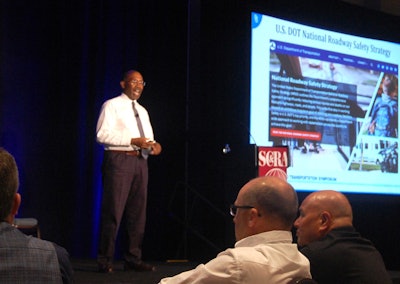Speaking at the annual Specialized Transportation Symposium of the Specialized Carriers & Rigging Association, held this year in Orlando, Florida, Federal Motor Carrier Safety Administration Associate Policy Administrator Larry Minor revealed plans for a possible rulemaking around the safety rating system. Today, carriers audited by the agency under any of its various audit types have the possibility of coming out at the end of the review with one of three ratings -- Satisfactory, Conditional or Unsatisfactory.
Minor noted the agency hopes to improve the rating process. "What direction should we go to improve our safety-rating process?" he said, noting FMCSA would publish an Advance Notice of Proposed Rulemaking later this year to assess industry viewpoints on the issue of ratings. The current system hasn't changed, he said, in well more than 20 years. It's been increasingly problematic, too, for carriers saddled with a Conditional rating after an adverse review to get the agency to return to their businesses to re-audit, with potential to upgrade them to Satisfactory.
Should the agency, Minor asked, perhaps consider a simpler Fit/Unfit two-tiered system?
The predominant trend in issued ratings has been sharply toward the negative in recent years, with a majority in 2021 issued being the adverse Conditional rating, as Overdrive reported last year.

"Compliance reviews are vastly weighted in favor of Conditional ratings" in the audit landscape today, said Fred Marcinak, transportation attorney with the Moseley Marcinak law group. FMCSA and its state partners are doing far fewer comprehensive on-site audits but rather looking at a carrier just "enough to get you Conditional or keep you unrated," hence the new majorities for Conditional ratings as of 2021, shown above.
Shares for 2022 aren't dissimilar at a quick glance, and more broadly the reality is that most audits/reviews do not result in a rating being issued at all, as Marcinak suggested. In 2022, for example, according to numbers derived from FMCSA's Analysis and Information portal, just approximately 3,700 of the nearly 13,000 audits of various types conducted resulted in any of the three ratings.
While clearly FMCSA has focused its investigatory efforts on carriers it believes are experencing negative safety outcomes, the dearth of Satisfactory ratings has increasingly been a point of contention for small carriers and brokerages who feel it should be the agency's responsibility to offer guidance on whether a carrier is simply fit or unfit to operate -- today, unrated carriers are judged by outside parties simply by way of analysis systems like the CSA Safety Measurement System that offer users data related to safety management controls and performance, which they can interpret themselves.
[Related: FMCSA's safety ratings trend sharply negative: A majority issued in 2021 were 'Conditional']
 Larry Minor, pictured on stage at the Specialized Transportation Symposium in Orlando, referenced rulemakings in progress. Minor also noted carriers can expect more details on a mandate for use of speed-limiting technology later this year, after its 2022 notice of intent to proceed with rulemaking requested industry input.
Larry Minor, pictured on stage at the Specialized Transportation Symposium in Orlando, referenced rulemakings in progress. Minor also noted carriers can expect more details on a mandate for use of speed-limiting technology later this year, after its 2022 notice of intent to proceed with rulemaking requested industry input.
He pointed to legislation introduced this year in the House of Representatives that would define a carrier-selection standard for intermediaries as a potential fix at least for some of those entities liability woes. The broker and freight forwarder group Transportation Intermediaries Association has trumpeted that recent legislation, which would institute a standard for carrier selection for intermediaries and shippers that relies solely on the carrier not being unfit to operate, or having an Unsatisfactory rating under the current system, generally speaking.
The bill, called the Motor Carrier Safety Selection Act, would also require a data-driven approach to determinations of who is not fit to operate. TIA seems to favor FMCSA moving "away from the outdated and ineffective current physical audit system" toward an offsite audit-focused system. As noted earlier, the current system results in many carriers classified with a "Conditional" safety rating for years waiting on an FMCSA audit to change that rating -- or no rating at all. This leaves owner-operators and small fleets in those categories "between a rock and a hard place in terms of if they should be utilized or not" by brokers and shippers, said Chris Burroughs, VP of government affairs for TIA.
What TIA advocates for in this regard is in some ways similar seems to provide a "yes" answer to Larry Minor's hypothetical question about potential change to a binary Fit/Unfit safety rating system. It also in other ways mirrors the Motor Carriers for Regulatory Reform coalition's past advocacy for an at least biennial “desktop audit” conducted offsite (akin to an offsite version of FMCSA’s new entrant audits in some ways) of every carrier in the nation as perhaps the best solution to safety assessment possible for the universe of motor carriers.
That's in light of the difficulty of accurately assessing small carriers with a data-based approach, such as that envisioned by FMCSA's previously proposed Safety Fitness Determination rule in 2016. The rule was withdrawn the next year, and nothing in Minor's commentary at the SC&RA meeting suggested a revivification of that particular data-driven approach, partially involving CSA SMS results.
In fact, Minor noted the back-to-the-drawing board plan for an ANPRM this year around safety rating is something of a direct result of the broad concern in industry about involving the CSA SMS in safety rating.
The 2016 rule would have integrated on-road safety data from inspections, along with the results of carrier investigations and crash reports, to determine a motor carrier’s overall safety fitness on a monthly, updated basis.
Speaking of the CSA SMS, Minor encouraged SC&RA attendees to log into the agency's preview site for its proposed changes to the system. There, carriers will be able to see how a series of updates would impact their scores in a variety of safety categories, including some new additions. Read more about those changes and find how to comment at this link.
[Related: FMCSA proposes long-overdue CSA Safety Measurement System revamp]













